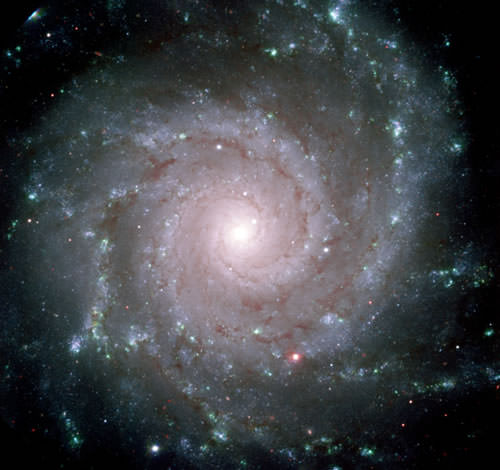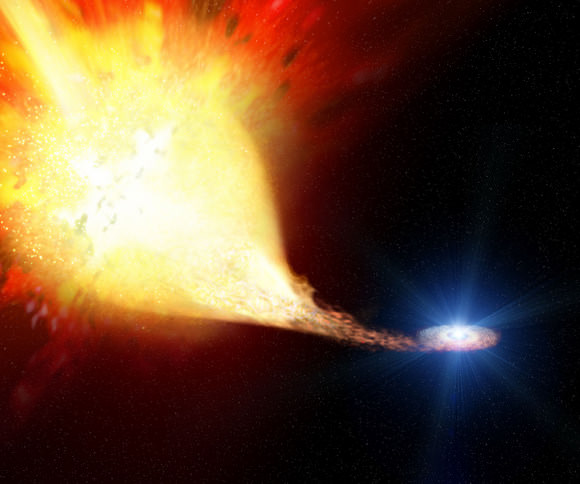Artist’s rendering of SN 1993J, where a red supergiant supernova progenitor star (left) is exploding after having transferred about seven solar masses of hydrogen gas to the blue companion star (right). Credit: ESA
Astronomers have caught two stars in the disappearing acts that link them to type II supernova events.
Type II supernovae are widely believed to result from the internal collapse and explosion of massive stars, about nine times the size of our sun. But precious few observations have actually confirmed the relationship.
Now, researchers have spotted two parent stars that showed up in supernovae “before” images — but not in images taken after the blasts.
“The disappearance of the progenitors confirms that these two supernovae were produced by Red Supergiants,” write co-authors Justyn Maund and Stephen Smartt. Their new paper is out in this week’s issue of Science.

So far only one star has been shown to have disappeared after it exploded — the star that exploded as SN 1987A in the Local Group of galaxies. Seven other stars have been spotted in the neighborhoods of type II supernovae before they went off, but none of them has been shown to have disappeared, Maund and Smartt write.
Maund is affiliated with both the University of Copenhagen in Denmark and the University of California at Santa Cruz, and Smartt is from Queen’s University Belfast in the UK. They used the Hubble Space Telescope and the Gemini Telescope to observe the two supernovae.
The progenitor of SN 2003gd, an M-supergiant star in the galaxy M74, “is no longer observed at the SN location,” they found. They estimated 2003gd is seven times the mass of the sun, which they acknowledge “is at the lower end of the mass range considered theoretically possible to produce core-collapse events.” They said there’s enough uncertainty in the object’s mass that it could be greater than seven solar masses — but even if it’s not, several other stars in the low end of the range are suspected of exploding as supernovae.
The co-authors are also careful to point out that dust from the supernova is still visible, and, “One could argue that the star identified as the progenitor was a neighboring star that is now obscured by dust formation.” But their work indicates that the explosion wasn’t dusty enough to obscure a star as luminous as SN 2003gd’s parent. They believe the progenitor star has truly disappeared — although further confirmation will come as the dust continues to clear.
SN 1993J is a truly exceptional case. The K-supergiant star that exploded in that supernova is also no longer present, the authors report — but its B-supergiant binary companion is still observed.
The model for the binary system was of a progenitor star 15 times the mass of the sun, with a slightly less massive binary companion. The progenitor star evolved faster, and transferred some of its mass onto the binary companion, including a substantial amount of its hydrogen envelope. The binary companion grew to 22 times the mass of the sun. The interaction happened over about 250 years and affected the supernova explosion to such an extent that SN 1993J became known as one of the most peculiar supernovae ever seen.
The site of SN 1993J was imaged several times over the 2 to 13 years after the explosion with Hubble and a handful of other telescopes. By the 2004 observation, the red portion of the SN spectral energy distribution had faded below the level of the red spectral energy of the binary progenitor system, “ruling out the continued presence of the K-supergiant star and, hence, confirming it as the progenitor of SN 1993J,” the authors wrote.
They said soon the blue part of the supernova’s spectrum will fade, opening up a window for observations of the remaining companion star.
The authors conclude that their “simple, but time-consuming” method “leaves no doubt that the two stars were the progenitors of the supernovas, SN 2003gd and SN 1993J, and confirms that type II supernovas are birthed from Red Supergiants, as predicted.”


“You can observe a lot by watching.” — Yogi Berra, athlete/philosopher, 1963
OilIsMastery Said:
For myself, and probably the majority of posters here, I would suggest for you it would be;
“You can learn a lot by listening” — S.B.Crumb 2009
Salacious,
If you think I’m interested in your suggestions you’re obviously out of your mind.
if your not interested in other peoples opinions or suggestions then why do you continue to post?
“OilIsMastery can learn alot… there is certainly room for that” – Excalibur 2009
Trippy,
“if your not interested in other peoples opinions or suggestions then why do you continue to post?”
I didn’t say, nor did I ever say, I’m “not interested in other peoples opinions”, but literacy and reading comprehension has never been your strong point.
What I said was I’m not interested in Salcious’s suggestions.
Are you suggesting that Salicous B Crumb doesn’t qualify as other people? Or are you suggesting that he doesn’t have an opinion, because those are the only two ways your comment even comes close to making sense.
Wow – this degenerates into a bitch fight at the drop of a hat these days. Not that I don’t like to participate in a bit of rambunctiousness, but in every single article?
Anyway, here’s one from me, and I know you all want to hear it because all of my ideas are literally and by definition, the best.
– “You can learn a lot by observing the universe, thinking about it and concocting a rational framework that interprets and gives meaning to such observations. This framework then makes further predictions that can be subsequently compared to further observations to examine it for flaws, and the framework is subsequently modified or abandoned for a new and better theory.”
I just thought of that then, so I thought I’d better post it. Of course, it needs a bit of elaboration, but you get the gist. I think I’ll call my method something catchy like “science”. Think of the potential! Man I’m awesome.
Astrofiend,
I haven’t observed ALL of your ideas, so I cannot say whether or not I can validate your definition (“the best”)… but I can relate to this as a fiendishly brilliant idea. You might consider using the “TM” symbol with the word “science”. Some people reading this, I suspect, might want to use the term to mean something quite different.
Also, I’d feel more comfortable with the word “model” instead of “theory”. “Theory” often seems to get used to mean things like “gobbledygook” and “rant”, and confusion can arise.
When some people have nothing serious to say, they say something, no matter what.
And they like to reply, in a process that gets emptier and emptier and…
Does anyone know where the supernova is in the image for SN2003gd?
Is is the red-looking ‘star’ at about 5 o’clock?
I really love photographs of supernovae in other galaxies, somehow it is a reminder that they are not just drifting serenely, but violently alive as ours is.
Oills couldn’t learn anything complicated, if it was programmed into him “Matrix” style.
–OEQ, 2009
“One could argue that the star identified as the progenitor was a neighboring star that is now obscured by dust formation.”
One could argue that this amounts to ‘some small doubt, rather than ‘no doubt’; but hey, I know a lot of people with ‘no doubt’ there is a deity.
@ Becky WS, a good guess at where in the picture of M 74 is SN 2003gd, but check out the Gemini press release at http://www.gemini.edu/node/11244 for pictures to ID the supernova ‘before and after’ it went off. The pre-supernova image is quite faint, but is clearly seen.
I used to enjoy coming to this site. But lately, it has seemed tedious and a waste of time. Thank you Jon and Becky WS for reminding me of how it used to be.
The paper discussing these two supernova can be found here: http://arxiv.org/PS_cache/arxiv/pdf/0903/0903.3772v1.pdf . Also refer to the above article concerning SN 2005gl in NGC 266.